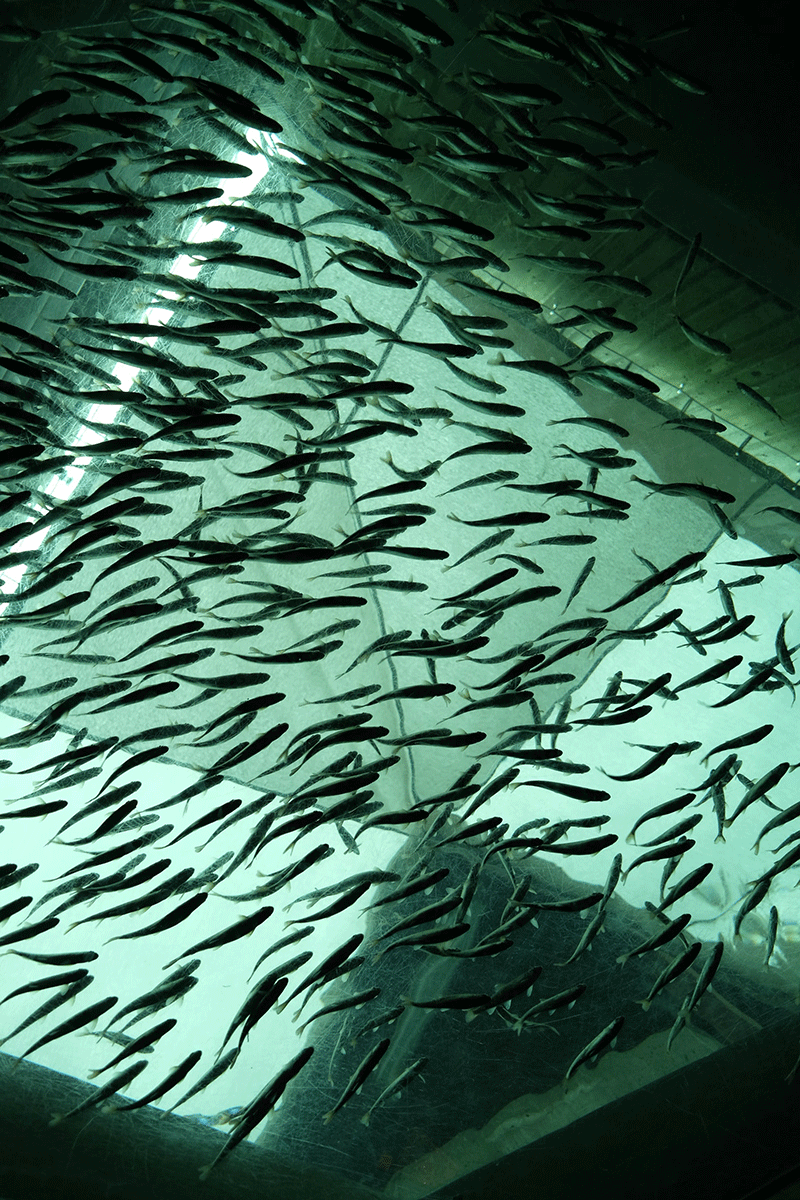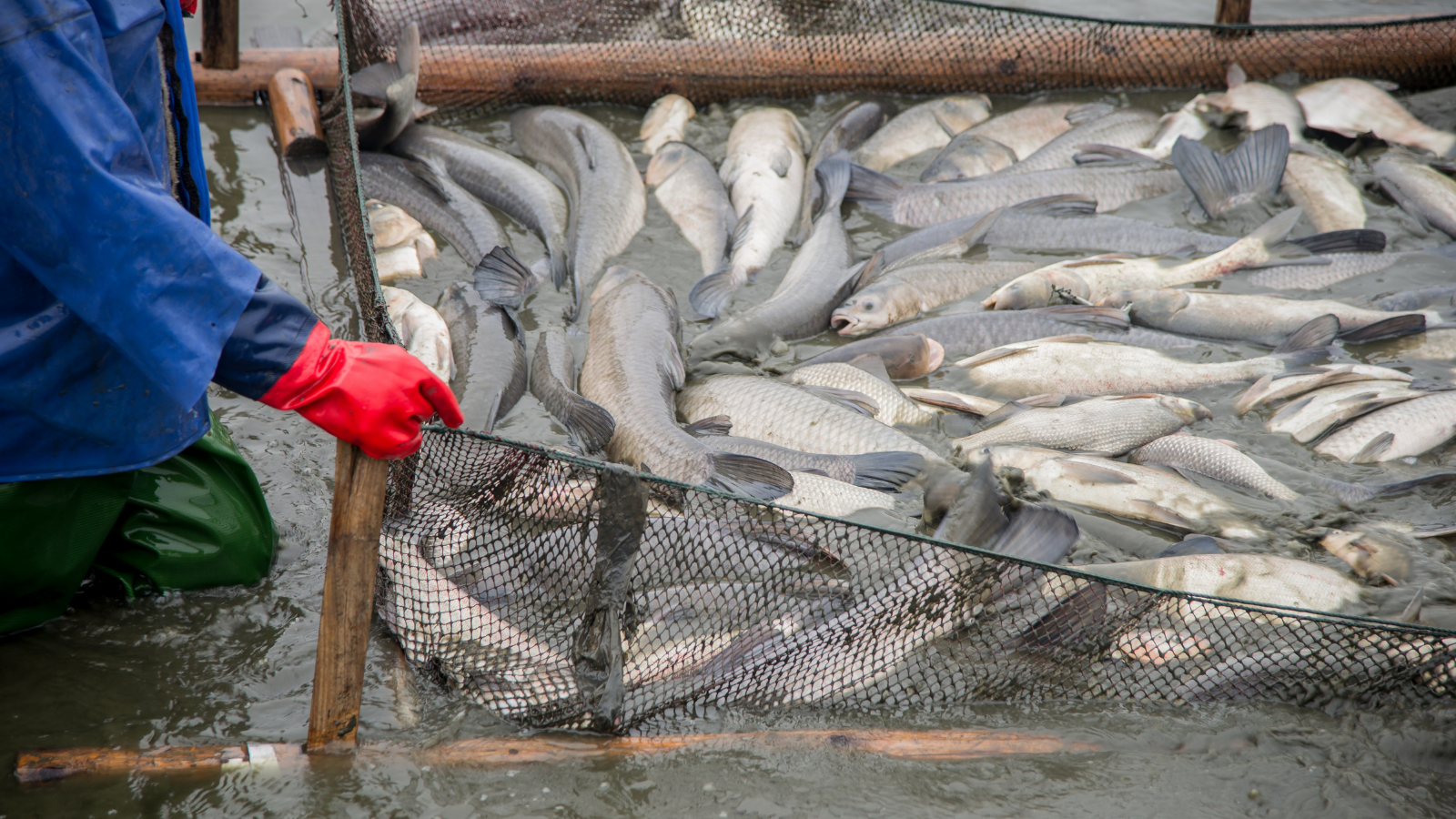Over a billion fish are farmed within the EU every year, and the EU imports farmed fish (especially salmon) from other countries. Lacking legislative requirements, there has been little attention from the aquaculture sector on reducing the harm caused by many common farming procedures, or on providing a good life for farmed fish.
Most farmed fish are around two years old when they are slaughtered, salmon are often 4 years old. It makes for a long life on farms where their welfare typically is not considered. Fish farms vary from net pens to concrete raceways to plastic tanks. Yet all these systems have common features: they are plain, barren environments, and face challenges to maintain good water quality. A farmed fish can expect to be crowded, taken out of water, size graded, moved, and inspected on multiple occasions during its life. In between, a routine of receiving pellet feed and whatever limited swimming opportunities the containment unit allows for. Finally, fish are starved before slaughter and normally killed by either asphyxiation or bleeding out without prior stunning.
Consensus is well established among experts and stakeholders that fish are sentient, emotional animals. This was reflected by EFSA in 2009. Fish welfare guidelines in aquaculture, applicable across species and production systems, during farming were developed by the Council of Europe in 2005, and during transport and slaughter by the World Organisation for Animal Health in 2009. Europe’s organic regulation has incorporated welfare requirements related to nutrition, health and environmental factors such as stocking density. National producer associations have increasingly developed and adopted regional and species relevant guidelines, including in Greece and Spain. Labelling schemes are increasingly incorporating fish welfare indicators.
Despite the increasing concern of citizens and the huge progress made in our understanding of best practices for fish welfare, there remains a lack of awareness and implementation of welfare measures in Europe’s aquaculture sector.
Fish in aquaculture are not domesticated animals. Most are carnivorous predators, and many of their species-specific needs are still unknown. The fundamentals required for rearing animals to have a good life are not in place for these animals.
fish farmed in Europe every year
think fish should receive the same protection as terrestrial farmed animals
think 'sustainable' should guarantee fish can behave naturally during farming
WHAT DOES THE PUBLIC THINK?
European citizens recognise that the fish pain ‘debate’ is well and truly over, and that fish are sentient animals with both positive and negative emotions, and with complex social and behavioural needs. This is clear in surveys, and in responses to media coverage and public campaigns.
In our own survey of 1,000 citizens in each of 9 EU countries, the answers on the above were very clear and strong. Additionally, it showed that people have a good idea of what is important for good fish welfare, ranking clean water, health, natural behaviours, and humane slaughter as the most important elements. There are many differences between fish and terrestrial animals, but they are the same in having needs related to their environment, health, behaviour, and nutrition driving their mental state. People have little trouble in understanding that fish are not so different in these fundamentals.
Of huge relevance for policymakers and the saturated market of ‘sustainable farmed fish’ labels, that are supposed to inform and reassure consumers, is that citizens expect a ‘sustainable’ fish to have had high welfare. In fact EU regulations and most of these sustainability labels contain no specific requirements for fish welfare.
POLICY - CURRENT STATE OF PLAY
EU farm animal welfare legislation makes only the general requirement to avoid pain and suffering during the farming and slaughter of farmed fish. The EU animal transport regulation includes fish within provisions on planning and documenting journeys, but sets no standards or practices that must be met.
Some individual countries have gone further. Germany has domestic legislation requiring effective stunning at slaughter and that fish farmers record behavioural indicators and certain water quality parameters. The Czech Republic also requires effective stunning at slaughter, and the Netherlands requires this only for eels. There are further examples beyond the EU, including Norway with a comprehensive approach to fish welfare regulations, Chile that places stricter stocking densities at the centre of its approach to fish health management, and countries including Switzerland and New Zealand requiring effective stunning at slaughter.










